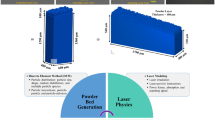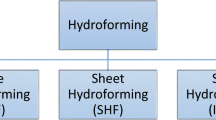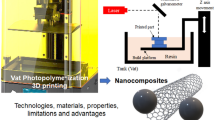Abstract
Micro injection molding enables the manufacture of micro-scale features with good accuracy at high production rates. However, the replication of complex micro and nano features is still challenging hindering the development of new functional surface topographies. The marked thermal gradient between injected polymer and mold surface and the reduced dimensions promote a rapid drop of melt temperature that causes the incomplete filling of the micro features. This study aims to investigate the combined effects of vacuum venting and mold wettability on the replication of micro-structured surfaces. A low-viscosity polystyrene and a cyclic olefin copolymer were selected and their wetting properties were evaluated. The results showed that a polymer with high wetting properties and an elevated viscosity dependence on temperature improves the replication of the micro features. Moreover, high interfacial effects can be exploited to significantly enhance the filling ratio when applying vacuum venting.













Similar content being viewed by others
References
Attia UM, Marson S, Alcock JR (2009) Micro-injection moulding of polymer microfluidic devices. Microfluid Nanofluid 7(1):1
Berger GR, Steffel C, Friesenbichler W (2016) A study on the role of wetting parameters on friction in injection moulding. Int J Mater Product Technol 52(1–2):193
Chien RD (2006) Micromolding of biochip devices designed with microchannels. Sens Actuators A Physi 128(2):238
Gava A, Lucchetta G (2012) On the performance of a viscoelastic constitutive model for micro injection moulding simulations. Express Polym Lett 6(5):417
Geoghegan M, Krausch G (2003) Wetting at polymer surfaces and interfaces. Prog Polym Sci 28(2):261
Gornik C (2004) Injection moulding of parts with microstructured surfaces for medical applications. Macromol Symp 217(1):365
Griffiths C, Tosello G, Dimov SS, Scholz S (2010) Cavity air flow behavior during filling in microinjection molding. J Manuf Sci Eng 133(1):1
Huang-Ya L, Wen-Bin Y (2009) Analysis of the filling capability to the microstructures in micro-injection molding. Appl Math Model 33(9):3746
ISO6721-1 (2011) Determination of dynamic mechanical properties—Part11: glass transition temperature
Lee N, Kim YK, Kang S (2004) Temperature dependence of anti-adhesion between a stamper with sub-micron patterns and the polymer in nano-moulding processes. J Phys D Appl Phys 37(12):1624
Lee N, Moon SD, Kang S, Ahn S (2003) The effect of wettability of nickel mold insert on the surface quality of molded microlenses. Opt Rev 10(4):290
Lucchetta G, Masato D, Sorgato M, Crema L, Savio E (2016) Effects of different mould coatings on polymer filling flow in thin-wall injection moulding. CIRP Annals Manuf Technol 65(1)
Lucchetta G, Ferraris E, Tristo G, Reynaerts D (2012) Influence of mould thermal properties on the replication of micro parts via injection moulding. Procedia CIRP 2(1):113
Lucchetta G, Sorgato M, Zanchetta E, Brusatin G, Guidi E, Di Liddo R, Conconi M (2015) Effect of injection molded micro-structured polystyrene surfaces on proliferation of mc3t3-e1 cells. Express Polym Lett 9(4):354
Lucchetta G, Sorgato M, Carmignato S, Savio E (2014) Investigating the technological limits of micro-injection molding in replicating high aspect ratio micro-structured surfaces. CIRP Annals Manuf Technol 63(1):521
Masato D, Sorgato M, Lucchetta G (2016) Analysis of the influence of part thickness on the replication of micro-structured surfaces by injection molding. Mater Design 95:219
Matschuk M, Larsen NB (2013) Injection molding of high aspect ratio sub-100 nm nanostructures. J Micromech Microeng 23(2):025003
Mosaddegh P, Angstadt DC (2008) Micron and sub-micron feature replication of amorphous polymers at elevated mold temperature without externally applied pressure. J Micromech Microeng 8(3):035036
Pranov H, Rasmussen HK, Larsen NB, Gadegaard N (2006) On the injection molding of nanostructured polymer surfaces. Polym Eng Sci 46(2):160
Rytka C, Kristiansen P, Neyer A (2015) Iso-and variothermal injection compression moulding of polymer micro-and nanostructures for optical and medical applications. J Micromech Microeng 25(6):065008
Rytka C, Opara N, Andersen NK, Kristiansen PM, Neyer A (2016) On the role of wetting, structure width, and flow characteristics in polymer replication on micro-and nanoscale. Macromol Mater Eng 301(5):597
Sha B, Dimov S, Griffiths C, Packianather M (2007) Investigation of micro-injection moulding: Factors affecting the replication quality. J Mater Process Tech 183(23):284
Sha B, Dimov S, Griffiths C, Packianather M (2007) Micro-injection moulding: Factors affecting the achievable aspect ratios. Int J Adv Manuf Technol 33(1–2):147
Shen YK, Chang CY, Shen YS, Hsu SC, Wu MW (2008) Analysis for microstructure of microlens arrays on micro-injection molding by numerical simulation. Int Commun Heat Mass Transf 35(6):723
Sorgato M, Babenko M, Lucchetta G, Whiteside B (2016) Investigation of the influence of vacuum venting on mould surface temperature in micro injection moulding. Int J Adv Manuf Technol pp 1–9
Srirojpinyo C, Yoon SH, Lee J, Mead J, Barry C (2005) Interfacial effects in replication of nano-scale features. Annu Tech Conf ANTEC. Conference Proceedings 2:323
Suzuki H, Takayama T, Ito H (2012) Replication behavior for micro surface features with high aspect ratio and structure development in injection compression molding. Int J Modern Phys Conf Ser 06:563
Tosello G, Gava A, Hansen H, Lucchetta G (2007) Influence of process parameters on the weld lines of a micro injection molded component. Proceedings of the Society of Plastics Engineers Annual Technical Conference ANTEC, (Cincinnati, OH, 6-11 May 2007): pp 2002–2006
Turi E (2012) Thermal characterization of polymeric materials, Elsevier
Xu G, Yu L, Lee LJ, Koelling KW (2005) Experimental and numerical studies of injection molding with microfeatures. Polym Eng Sci 45(6):866
Yao D, Kim B (2004) Scaling issues in miniaturization of injection molded parts. J Manuf Sci Eng 126(4):733
Yao D, Kim B (2002) Development of rapid heating and cooling systems for injection molding applications. Polym Eng Sci 42(12):2471
Yokoi H, Han X, Takahashi T, Kim W (2006) Effects of molding conditions on transcription molding of microscale prism patterns using ultra-high-speed injection molding. Polym Eng Sci 46(9):1140
Yoon SH, Padmanabha P, Cha NG, Mead J, Barry C (2011) Evaluation of vacuum venting for micro-injection molding. Int Polym Process 26:346
Yu L, Koh CG, Lee LJ, Koelling KW, Madou MJ (2002) Experimental investigation and numerical simulation of injection molding with micro-features. Polym Eng Sci 42(5):871
Zhang N, Chu J, Byrne CJ, Browne D, Gilchrist M (2012) Replication of micro/nano-scale features by micro injection molding with a bulk metallic glass mold insert. J Micromech Microeng 22(6):065019
Zitzenbacher G, Huang Z, Längauer M, Forsich C, Holzer C (2016) Wetting behavior of polymer melts on coated and uncoated tool steel surfaces. J Appl Polym Sci 133(21)
Author information
Authors and Affiliations
Corresponding author
Rights and permissions
About this article
Cite this article
Sorgato, M., Masato, D. & Lucchetta, G. Effect of vacuum venting and mold wettability on the replication of micro-structured surfaces. Microsyst Technol 23, 2543–2552 (2017). https://doi.org/10.1007/s00542-016-3038-5
Received:
Accepted:
Published:
Issue Date:
DOI: https://doi.org/10.1007/s00542-016-3038-5




